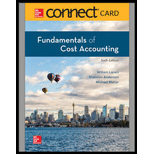
Concept explainers
a.
Calculate the allocation of cost based on the step method starting from maintenance.
a.
Answer to Problem 30E
The total cost allocation is $40,000 and $32,000 for machining and assembly, and there is no cost allocation in maintenance and cafeteria.
Explanation of Solution
Step method:
Step method allows the allocation of the cost to the production department and service departments. Unlike the direct method, it also allocates the cost of the service to various service departments. Allocation of the cost starts from the department that has provided the highest proposition of service to the department that has provided the least service. Step method allows only one-way allocation of cost among service departments.
Calculate the cost allocation based on the step method:
| Particular | Maintenance | Cafeteria | Machining | Assembly |
| Service department cost | $40,000 | $32,000 | ||
| Maintenance | $ (40,000) | $8,000 (1) | $20,000 (1) | $12,000 (1) |
| Cafeteria | $(40,000)(4) | $20,000(2) | $20,000(3) | |
| Total cost allocation | $0 | $0 | $40,000 | $32,000 |
Table: (1)
Thus, the total cost allocation is $40,000 and $32,000 for machining and assembly, and there is no cost allocation in maintenance and cafeteria.
Working note 1:
Calculate the maintenance cost allocation:
| Particulars |
Proposition (a) |
Total costs (b) |
Cost allocation |
| Cafeteria | 20% | $40,000 | $8,000 |
| Machining | 50% | $40,000 | $20,000 |
| Assembly | 30% | $40,000 | $12,000 |
Table: (1)
Working note 2:
Calculate the cafeteria cost for the machining department:
Working note 3:
Calculate the cafeteria cost for the assembly department:
Working note 4:
Calculate the cafeteria cost for the assembly department:
b.
Calculate the allocation of cost based on the step method starting from the cafeteria.
b.
Answer to Problem 30E
The total cost allocation is $44,200 and $27,800 for machining and assembly, and there is no cost allocation in maintenance and cafeteria.
Explanation of Solution
Cost allocation:
Cost allocation refers to the process of distributing the common cost of the production and service rendered to the various departments of the business. It is used to calculate the actual cost attributed to a specific department.
Calculate the cost allocation based on the step method:
| Particular | Maintenance | Cafeteria | Machining | Assembly |
| Service department cost | $32,000 | $40,000 | ||
| Maintenance | $ (32,000) | $25,600(4) | $3,200(4) | $3,200(4) |
| Cafeteria | $(65,600)(7) | $41,000(5) | $24,600(6) | |
| Total cost allocation | $0 | $0 | $44,200 | $27,800 |
Table: (2)
Thus, the total cost allocation is $44,200 and $27,800 for machining and assembly, and there is no cost allocation in maintenance and cafeteria.
Working note 4:
Calculate the cafeteria cost allocation:
| Particulars |
Proposition (a) |
Total costs (b) |
Cost allocation |
| Cafeteria | 80% | $32,000 | $25,600 |
| Machining | 10% | $32,000 | $3,200 |
| Assembly | 10% | $32,000 | $3,200 |
Table: (3)
Working note 5:
Calculate the maintenance cost for the machining department:
Working note 6:
Calculate the maintenance cost for the assembly department:
Working note 7:
Calculate the maintenance cost for the assembly department:
Want to see more full solutions like this?
Chapter 11 Solutions
Connect Access Card For Fundamentals Of Cost Accounting
- Please provide the answer to this general accounting question using the right approach.arrow_forwardAt the beginning of the year, Alamo Trading's liabilities equal $125,000. During the year, assets increased by $95,000, and at the end of the year, assets equal $315,000. Liabilities decrease by $41,000 during the year. Calculate the amount of equity at the end of the year.arrow_forwardPlease give me true answer this financial accounting questionarrow_forward
- Financial Accounting Questionarrow_forwardV Industries has sales of $240,000 and the cost of goods available for sale of $198,000. If the gross profit rate is 32.75%, the estimated cost of the ending inventory under the gross profit method is?arrow_forwardI need help with this general accounting question using standard accounting techniques.arrow_forward
- Can you demonstrate the accurate steps for solving this financial accounting problem with valid procedures?arrow_forwardCan you explain this financial accounting question using accurate calculation methods?arrow_forwardI need help with this general accounting problem using proper accounting guidelines.arrow_forward
- Use the information provided to answer following questions Larry Ltd. is a registered VAT taxpayer. His business transactions for the months of January to March are included below. The VAT rate is 12.5%. All the amounts given are VAT inclusive. Months Sales Purchases Imports January $50,625 $30,375 $17,662.50 February $63,337.50 $38,475 $25,087.50 March $67,500 $52,312.50 $22,612.50 1. What is the Larry Ltd. VAT input tax for the 3 months period? A.$7,262.50 B.$13,462.50 C.$20,725 D.$20,162.50 2. What is the Larry Ltd. VAT output tax for the 3 months period? A.$20,152.50 B.$7,037.50 C.$5,812.50 D.$20,162.50 3. What is the Larry Ltd. VAT payable/refund for the 3 months period? A.$13,125 payable B.$1,562.50 refund C.$562.50 refund D.$20,143.50 payablearrow_forwardPlease explain the solution to this general accounting problem with accurate principles.arrow_forwardNeed helparrow_forward

 AccountingAccountingISBN:9781337272094Author:WARREN, Carl S., Reeve, James M., Duchac, Jonathan E.Publisher:Cengage Learning,
AccountingAccountingISBN:9781337272094Author:WARREN, Carl S., Reeve, James M., Duchac, Jonathan E.Publisher:Cengage Learning, Accounting Information SystemsAccountingISBN:9781337619202Author:Hall, James A.Publisher:Cengage Learning,
Accounting Information SystemsAccountingISBN:9781337619202Author:Hall, James A.Publisher:Cengage Learning, Horngren's Cost Accounting: A Managerial Emphasis...AccountingISBN:9780134475585Author:Srikant M. Datar, Madhav V. RajanPublisher:PEARSON
Horngren's Cost Accounting: A Managerial Emphasis...AccountingISBN:9780134475585Author:Srikant M. Datar, Madhav V. RajanPublisher:PEARSON Intermediate AccountingAccountingISBN:9781259722660Author:J. David Spiceland, Mark W. Nelson, Wayne M ThomasPublisher:McGraw-Hill Education
Intermediate AccountingAccountingISBN:9781259722660Author:J. David Spiceland, Mark W. Nelson, Wayne M ThomasPublisher:McGraw-Hill Education Financial and Managerial AccountingAccountingISBN:9781259726705Author:John J Wild, Ken W. Shaw, Barbara Chiappetta Fundamental Accounting PrinciplesPublisher:McGraw-Hill Education
Financial and Managerial AccountingAccountingISBN:9781259726705Author:John J Wild, Ken W. Shaw, Barbara Chiappetta Fundamental Accounting PrinciplesPublisher:McGraw-Hill Education





